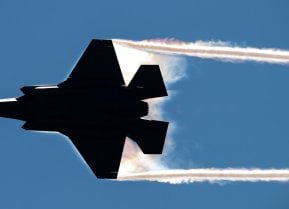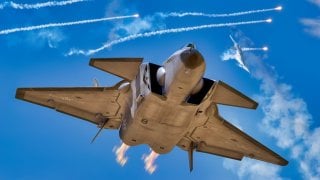China's J-20 Stealth Fighter: Created with Stolen Technology from F-22 and F-35?
Did China steal F-22 and F-35 designs to benefit its ongoing fighter efforts? The answer is unequivocally yes. But is that a reason to dismiss the threat posed by these aircraft and others to follow? No.
Summary: The article discusses allegations and evidence of China's theft of American stealth fighter designs. It outlines how Su Bin, a Chinese national, pled guilty to conspiring with the Chinese military to steal military secrets from the United States, including designs for the F-22 and F-35 stealth fighters.
It’s not uncommon to hear people say that China’s most advanced stealth fighters, the in-service Chengdu J-20 and forthcoming Shenyang FC-31, incorporate stolen design elements from existing American and Russian fighter programs. Russian allegations of copycat technology are born largely out of overall similarities between the J-20 and Russia’s long-defunct MiG 1.44 program. However, although Russian allegations leave at least some room for debate the same can’t be said for China’s theft of American stealth fighter designs.
In March 2016, a 51-year-old Chinese national named Su Bin pled guilty to charges associated with what the American Justice Department described as a “years-long conspiracy” conducted in concert with high-ranking members of the Chinese military to steal American military secrets – most notably, the designs for advanced stealth fighters like the F-22 and F-35.
“Su admitted that he conspired with two persons in China from October 2008 to March 2014 to gain unauthorized access to protected computer networks in the United States – including computers belonging to the Boeing Company in Orange County, California – to obtain sensitive military information and to export that information illegally from the United States to China,” reads the Justice Department release.
Su Bin, who worked in Canada under the name Stephen Su, was a well-regarded businessman and entrepreneur in the aviation industry, serving as the sole proprietor of a small company that specialized in aircraft cable harnesses. This company, called Lode-Tech, was described by the Air Force Office of Special Investigations as a “small player” in the field, with only a handful of employees and limited access to broader aviation programs.
However, despite the minimal reach of Lode-Tech, Su Bin himself worked tirelessly to establish in-roads within the Canadian and American defense industries, forming an extensive network of business contacts that, over time, allowed him to gain increasingly unfettered access to internal networks maintained by a variety of American and Canadian defense contractors.
As Bob Anderson, the FBI’s former head of counterintelligence, put it, “he cultivates you over time.”
China began formal development on its first stealth fighter, meant to compete directly with Western jets like the F-22, in 2008, awarding the Chengdu Aerospace Corporation a developmental contract meant to mature its Project 718 design proposal.
Starting that same year, Su began working directly with two professional hackers employed by China’s People’s Liberation Army, using the information he’d gained through his business contacts to enable the theft of more than 630,000 files from Boeing – a massive 65 gigabytes of data – related to the C-17 heavy-lift cargo aircraft. But Su had his sights set on an even bigger prize: information regarding America’s stealth fighter programs.
Over time, Su’s ability to win over business contacts enabled the theft of even more information mostly on the development of Lockheed Martin’s F-22 Raptor and F-35 Lightning II. While Su did not immediately have access to Lockheed Martin’s networks, these aircraft were not designed or built solely within the halls of Lockheed Martin. Both of these fighters represent the efforts of a chorus of contractors and subcontractors, with design specifications shared across firms for the sake of manufacturing.
When people took note of Su’s interest in these classified programs, he assuaged their concerns by pointing out that he was only asking about specific, seemingly unimportant things.
“Su would say, ‘I’m not asking you to give me the F-35, but what’s it matter if I get one system out of it that we could sell to a friend or a prospective client?’” said Anderson. “And then go from there, and it takes time.”
Over at least six years, Su and his hackers would gain access to tens of thousands of files associated with these stealth fighter programs.
Correspondence between Su and his team shows he not only provided overall direction and guidance for this effort, but he even worked to translate the stolen information into Chinese, going so far as to draft formal reports for the PLA’s General Staff Headquarters on the material they managed to steal.
Su and his co-conspirators may have worked tirelessly to gain access to this information, but they worked just as hard to cover their tracks. FBI counter-intelligence experts traced their work through multiple third-party nations, where they had established “hop points” – a term used to describe compromised or purchased intermediary networks meant to disguise the infiltration’s actual point of origin.
In 2009, six current and former government officials confirmed with the Wall Street Journal that the Joint Strike Fighter Program that produced the F-35 had been accessed multiple times by Chinese hackers, who had secured several terabytes of information regarding the aircraft’s design and systems. At the time, Pentagon officials explained that the hackers used a method that encrypted data as it was being stolen, making it difficult to assess what specific data had been compromised. However, it is worth noting that some of the most secretive systems being developed for the aircraft are kept isolated from broader network access to avoid these sorts of security breaches. Nonetheless, this revelation was the beginning of the end for Su and his team.
In one 2011 e-mail entered into evidence, Su bragged to his Chinese contacts that the information they stole from the F-22 and F-35 programs would “allow us to rapidly catch up with U.S. levels … To stand easily on the giant’s shoulders.”
Beginning in 2011, in what Chinese officials might describe as little more than coincidental timing, the J-20 fighter design that had been maturing since 2008 suddenly adopted several significant – and stealthy – changes. These changes wouldn’t manifest in a new prototype, however, for three more years.
By 2013, Su had also established connections with GE Aviation in Cincinnati – a firm renowned for advanced turbofan technologies that China has struggled to develop for its own stealth fighters. It’s worth noting that both the F-22 and F-35 are powered by Pratt & Whitney powerplants, but GE was responsible for competing designs meant for service aboard these jets. According to Defense Department insiders, GE’s YF120 turbofan proposal for the F-22 Raptor was actually the more advanced and capable design. Pratt’s YF119 engine ultimately won out due to its simplicity and the lower risk associated with relying on more mature and proven technologies.
In March 2014, China’s new and improved J-20 design finally emerged, incorporating modified diverterless supersonic inlets (DSI), redesigned vertical stabilizers, and more. When pictures of the new J-20 first reached the internet, multiple defense outlets highlighted the now even more pronounced similarities to Lockheed Martin’s stealth fighters.
As well-known aviation journalist David Cenciotti reported at the time, the J-20’s newly redesigned nose, in particular, bore a striking resemblance to the F-22 and F-35. That same year, USNI News contributor Feng Cao also drew direct comparisons to America’s stealth fighters, even highlighting its change in color to “F-22 grey,” likely a sign of improved radar-absorbent skin. Defense outlet War is Boring was so taken by the improved features of the new J-20 design that they ran a story with the headline, “China’s Latest Stealth Fighter Prototype Has, Well, Actual Stealth Features.”
Now, it is important to note that not all of the design changes to the J-20 are easily attributed to espionage. Some changes and improvements can be traced to on-record developmental efforts within Chinese academia… but not all of them. Nonetheless, the new-and-improved J-20 could be seen as a massive victory for Su Bin and his espionage efforts… but he wouldn’t have much time to celebrate. At right around the same time the new J-20 prototype was revealed to the world, the U.S. Department of Justice filed a criminal complaint and subsequent indictment against Su for the theft of thousands of files associated with American defense efforts. Four months later, in July 2014, he was arrested by Canadian authorities.
While the FBI is traditionally responsible for investigating these sorts of crimes, the Air Force’s Office of Special Projects (PJ), a subset of the Office of Special Investigations, ultimately played a vital role in securing Bin’s arrest and extradition to the United States thanks to their ability to work directly with defense contractors and senior U.S. government officials, including members of the Air Force’s C-17 program office and others within Lockheed Martin itself.
American law enforcement eventually managed to access the messages exchanged between Su, his hackers, and Chinese military officials in which they wrote and revised formal reports for the People’s Liberation Army outlining their efforts and the data they’d managed to steal. The collection of stolen files combined with this correspondence left the charges all but irrefutable, and Su opted to wave the extradition hearing and be transferred directly to the United States.
Initially, Su was facing 30 years in prison for his crimes, but he quickly accepted a plea agreement, providing his full cooperation to American authorities in exchange for a much shorter 46-month sentence.


